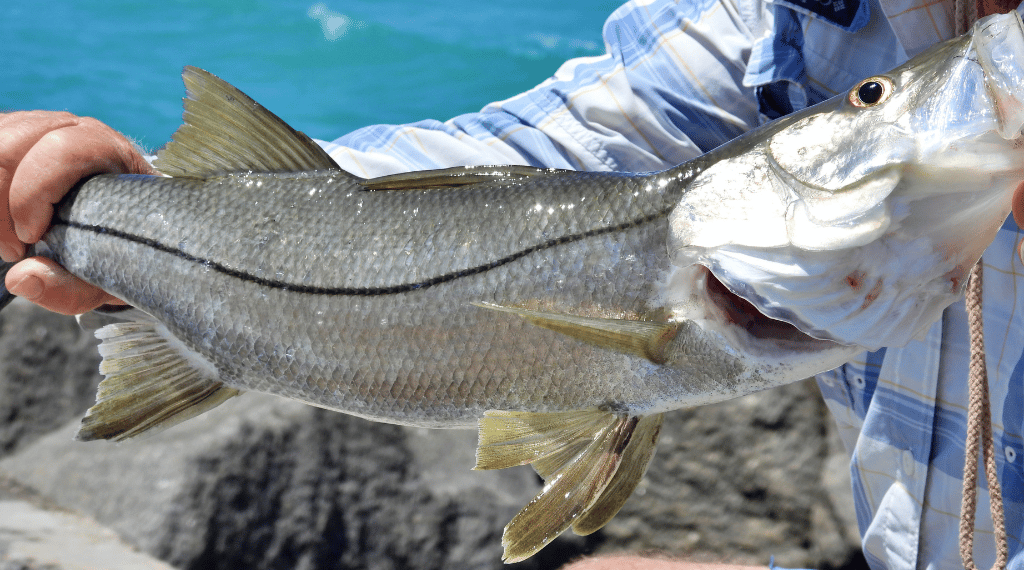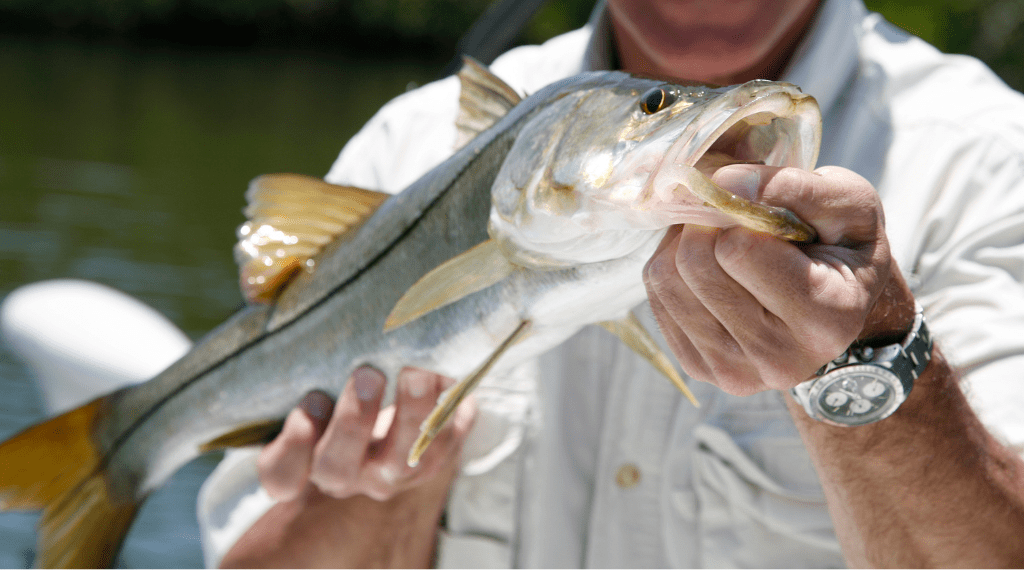Snook are a really popular species of fish, especially down in Florida. Snook demands the attention of both the most experienced and novice fisherman.
While they are a fairly common catch, you’ll usually just reel in small snook.
Catching a large snook, however, can be more challenging. Most fishing enthusiasts love to show off their photos when they land a large snook.
Throughout this article, I’ll go through some of the best ways to ensure you can reel in one of the big ones. So read on to learn how to catch snook.
What Is A Snook
Snook, also known as robalo, is a species of game fish that you’ll find in both the Atlantic and Pacific sides of Northern and Southern America.
You’ll tend to find these fish under docks and bridges as well as around any other inshore structure or cover.
You’ll often hear of them being referred to as linesiders. This is because of their pronounced lateral line that helps them to catch their food in their dark and dingy water.
Snook can inhabit both salt and fresh water as there are several species of this fish.
These fish tend to eat smaller fish as well as crustaceans such as shrimp.
You’ll know that you’ve caught one of these by the characteristic ‘thumping’ sound that they make when they hit the bait.
Now if you do hook a snook, be prepared for a fight as they don’t go easy, often doing dogged runs and gill-rattling jumps to try and escape.
Now, these fish do not have teeth, but you should look out for their sharp gill plate.
Whether you release the fish or decide to keep it as a tasty treat is up to you. They do have a high culinary rating.
You just need to be careful where you are fishing and whether you can actually keep your fish, as there are heavy regulations throughout most of the US.
Snook Tackle
For your snook tackle, a light saltwater spinning rod setup or a baitcasting setup will probably be the most effective. You’ll want the braid to be around 30lbs to be good universally.

Your fluorocarbon leader needs to be anywhere between 15lbs to 40lbs. This will really depend on how big the fish you’re reeling is and the clarity of the water you are fishing in.
As a rule, I think that circle hooks work the best if you’re planning on releasing the fish, which more often than not will be the case due to the regulations.
The Daiwa Cerate is probably the most effective spinning reel in my personal opinion.
The Best Techniques To Use To Catch Snook
It probably goes without saying that you’re going to need to cast your rod where these fish live if you want any hope of catching them.
Place yourself beside a dock or near any type of covered structure.
Snook are pretty sensitive to the movement of the tide so you’ll need to consider this too when picking your fishing base.
If you can, try to fish at nighttime, especially when there’s a full moon, and you’ll find that the sea is brimming with these fish in abundance. This is prime time to reel in a big catch.
Sometimes even if you can see the water below filled with snook, they may completely ignore the bait which can seem frustrating. But this can be due to the tides too.
Be patient and wait for the change in tide direction and see how quickly they begin to feed.
If the tide is not going the right way, these stubborn fish won’t bite, so it’s imperative to take the tide into consideration.
Another perfect target for catching snook is a river mouth as long as they haven’t already been netted as they are extremely susceptible to this.

Snook Lures
What are the best snook lures to use to ensure a catch? In my experience, I find that bucktail jigs that have tails made of plastic will have the most success.
They are the most popular choice in Central America. Other options such as DOA shrimp and Jerk Shads will also do the job.
Snook tend to feed quite a lot at night time. So your best time of day for a catch is either just before nightfall or early in the morning before the sun has fully risen.
Snook Baits
Which bait is the best to use can depend on exactly where you choose to fish.
It’s best practice to try and catch bait close to where you fish. Live shrimp, mullet, pilchards, and sardines are all great choices.
Dangling some of this bait in the places they often ambush prey, such as by mangroves and docks, will be irresistible to your snooks and you’re likely to reel them in.

Where To Find The Big Snook
As mentioned before, smaller snook can be fairly common to reel in.
If you’re looking for more of a challenge and want to get one of the bigger fish for a photo, you’ll need to find the right places to look for them.
Costa rice and both pacific sides of the Caribbean are plentiful with big snook fish.
If this is a bit far for a fishing trip you can always try most parts of Florida. As they are home to much bigger snook, but not only are these snook bigger, they tend to be smarter.
So if you hope to reel in one of them here, you’ll need to seriously practice your snook-catching skills.
Final Thoughts
Snook are a fairly common species and so catching one isn’t necessarily all that difficult.
That doesn’t apply to the larger fish though, so if you’re hoping to catch one of these you’ll need a little more patience and expertise.
To improve your chances of catching a bigger score, you’ll need to ensure that you use the best lures, baits, and tackles.
Not only that but you’ll want to ensure that you are fishing in the optimum spot, taking the tide into consideration, at a time with low-light levels such as early morning, or late evening just before nightfall.
Want to know more about how to catch snook? Check out this great youtube clip for tips about Catching Snook From The Beach (When Fishing From A Boat).

